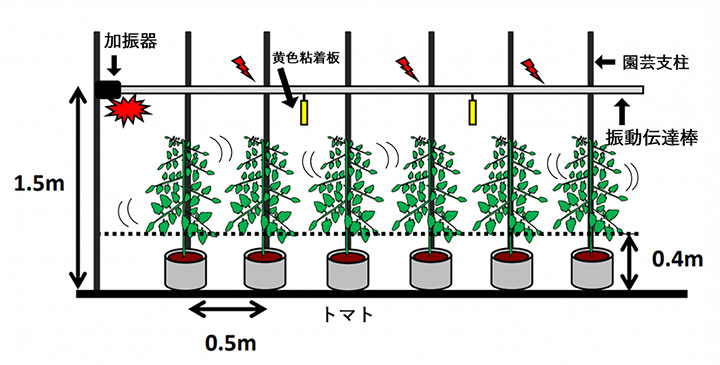

琉球大:振動与えて害虫減らせ:トマトで効果(動画):
Ryukyu Univ: Give vibration to reduce pests: Effective with tomatoes:
琉球大学:振动以减少害虫:对西红柿有效
琉球大と森林総合研究所:
研究チームが、12月30日に発表した。
農薬減期待苗に小刻みに振動を与えることで、トマトに付く害虫を減らす効果が確認できた。
農薬散布量を減らす:
振動によるストレスで、害虫が逃げたり交尾しなくなったりすると考えられる。
琉球大:
立田晴記教授が「うまく使えば、農薬を散布する量を減らせる」と指摘した。
3年後、装置を実用化することを目指す。
タバココナジラミ:
害虫は体長約1ミリのタバココナジラミ。
- トマトの葉から栄養を吸い取り、
- 植物を枯らすウイルスを広げ、
- 農薬に耐性を持つタイプが現れ、
対策が課題となっている。
東京新聞 TOKYO Web
https://www.tokyo-np.co.jp/article/77416
振動による新たなタバココナジラミの防除法を開発
森林総合研究所、琉球大学:
タバココナジラミ:
タバココナジラミは、トマトをはじめとした様々な野菜、観葉植物、花き類を加害する重要農業害虫で、ほとんどの化学農薬に対して薬剤耐性を示す。
そのため、化学農薬だけに頼らない新たな防除技術が求めてられてきた。
新たな防除技術:
研究グループは、昆虫の振動に対する感受性に着目し、これまで研究を進めてきた。
昆虫の振動感受性:
その結果、加振区の成虫と幼虫の密度は、無加振区と比べ減少した。
特に幼虫の場合、加振区では、無加振区よりも、40%減少が確認したことが確認された。
これにより、植物体に振動を与えることで、植物上のタバココナジラミの個体数を減少させられることが明らかになった。
ニュース|農政|JAcom 農業協同組合新聞
https://www.jacom.or.jp/nousei/news/2020/12/201209-48199.php
Applied Entomology and Zoology (2020)
Substrate-borne vibrations reduced the density of tobacco whitefly Bemisia tabaci (Hemiptera: Aleyrodidae) infestations on tomato,
Solanum lycopersicum : an experimental assessment
Abstract
We aimed to examine
whether substrate-borne vibrations effectively drive away tobacco whiteflies [Bemisia tabaci Gennadius (Hemiptera: Aleyrodidae)], which are serious agricultural pests.
To do so, B. tabaci individualswere artificially introduced into greenhouses where tomato (Solanum lycopersicum L.) plants were reared.
A substantial reduction in the average density of B. tabaci nymphs and adults was achieved by transmitting vibrational stimuli to the plants.
At the same time, no obvious reduction was found in the number of tomato plant flowers.
Although the performance of the vibrational device and transmission
procedures requires further improvement, the present results shed light on the potential of substrate-borne vibrations as a promising alternative for pest management.
SpringerLink
https://link.springer.com/article/10.1007/s13355-020-00711-9